March, 17th,
2003
Our last night as a family in Dundee
My day began with a brief BBC Radio Scotland
interview on the dock by the Royal Research Ship, Discovery. I was asked
what I thought about Discovery and I pretty well quoted the children and
their reaction to our day in the Visitor’s Center.
The cab back to Dunlaw
House was interesting. I must have met the only taxi driver in doontoon
Dundee who didn’t know where the Conshie Brae was! So I had to tell him.
Nor did he know we were
past the one way section – "Don’t go up there," I said. "It’s one way."
"No, it’s not. It’s OK." He
replied.
"Stop!" I shouted. "See the
sign – red circle, white line? I know that means do not enter
because my girl friend and I went through one just like that twice this
week already!" So, in the end, he backed on out and off we went the way
I’d previously suggested, along Bell Street, round the Berrick Park and
the Dundee Royal Infirmary, back along Constitution Street, then down the
Conshie and into Union Terrace, the authorized one way direction.
When I told the children,
they informed me I can stay in Scotland and get a job as a tour guide –
even moonlight as a taxi driver - because every time we turn a corner I
either have another story or embark on a new adventure.
We had a wonderful day
again. What began as a misty, moisty morning cleared up to bright sunshine
we headed into the Carse of Gowrie and our day in Perthshire.
Steve presented us all with
the craziest Tam O’ Shanters – bright red tartan, with a shock of orange
faux hair attached wig fashion. We laughed so hard at each other and
concluded we must be Rowan Travel’s "red headed stepchildren" and wore
them most of the day.
First of all we went out to
Baldragon to see the Pictish stone there (approx 500 BC) in the Sidlaws. I
retold the story of Dundee’s dragon slayer, Martin of the Nine Wells,
avenging the deaths of his beautiful daughters by chasing the dragon that
ate them. The chase went all the way out of Dundee while the townspeople
lined the streets and cried, "Strik, Mertin, strik!" according to my
granny and thus Strathmartine Road was named because the dragon in its
fear of Martin, breathed fire and laid open the road as it vainly tried to
escape.
I told my family to pay no
attention to their lying intellects or archaeological proof re Pictish
habits, because my Granny and her grannies before her all handed down the
story that this stone marks the spot where Mertin killed the dragon.
Like any great story, I got
my version from my granny, who got it from hers, and the story changes and
grows with each storyteller who passes it on, adding a little of the
cultural flair of the time. I’m thinking – maybe that should be my next
project, a little storybook of our version of "Baldragon Tales."
What a sight my family was
at the dragon stone. We drifted out of the early morning mist before the
stone, with our tams and wild red hair. Some of my children had travel
blankets wrapped around their shoulders and, unable to find the gate into
the field as we fumbled forward, they climbed the dyke and over the next
barbed wire fence and went running and leaping into the mist with wild
Highland yells toward the stone.
Laughing hysterically
watching the back end of this advancing army, all I could see was heads of
orange hair drifting in and out as they danced wildly, like witches "all
in a breeze" to quote Burns’ description of Kirk Alloway on Hallowe’en
with the de’il, around and around the stone.
Ah, my granny would have
proud of the children I’ve raised.
After paying our respects
to our Pictish past, we headed up towards Lundie where our Duncan
ancestors are from: Admiral Lord Adam Duncan, Viscount Dundee, the "hero
of Camperdown" being my fifth great uncle, and Jean Duncan, daughter of
John Duncan of Lundie and wife of John Benvie of Kinfauns, and after his
death, wife of William Morrison of a Dundee jute manufacturing family,
being my fourth great grandmother. We turned our thoughts to those who had
worshipped at Lundie’s little Presbyterian church and I found a gravestone
dating back to 1759. I also found an undated stone in the graveyard with
the traditional sign of death, a skull and crossbones, carved into the
granite.
A little grouse ran across
my path, reminding me of American quails where here in the southwest they
are a symbol of family, and seeming a promise of good things to come in
the day ahead because we planned to visit Famous Grouse Distillery in
Crieff.
The Famous Grouse
Experience was interesting and fun, even for nine year old Nathan and
eleven year old Xylia. We learned about single and blended malt whisky,
legal and illegal (this is the oldest legal distillery in Scotland)
distilling, mash, and malt and balm, and how whisky making is
exceptionally environmentally recyclable, and we practiced our "nosing"
techniques to use when enjoying and appreciating a wee dram.
The setting at the Famous
Grouse, alongside riverwalks beside the Tay, is beautiful and the guides
and staff are exceptionally courteous and hospitable. The grandchildren
really enjoyed the audio visual experience at the end of the tour – Nathan
and Xylia leading the adults in our Whisky Galore type tour in running all
over the images that appeared under our feet on the floor that turned out
to be the screen: chasing ice and experiencing other fun visuals from the
company ads, putting a jigsaw puzzle together, dancing with the Famous
Grouse, etc. Nathan was particularly taken with being able to put together
a symphony of sound in the "dramming room" to show how a good whisky is
like music with all the different elements working together (water,
environment, the people of the area, the barley and the casks and aging,
etc.) to bring about the right note. I hope he’ll never be a drinker, but
I also hope he’ll understand and appreciate the history and techniques of
a fine Scottish single malt water of life.
Our next stop – after
shopping for souvenirs in the Famous Grouse shop (I got a nice, available
only in Scotland, whisky liquor for my boss that she had asked me to buy
for her while on our trip) we drove into Crieff for our usual late lunch.
I remember Crieff from my
"day here and there" holidays as a child with my mother and gran. Our
family Crieff story is that my brother as a child, one fine summer day,
fell into the park paddling pool there and got "a’ drookit." In those
days, my mother told me, Crieff Park was surrounded by residences of the
well to do. My poor mother and granny had to go door to door, "Like
tinkies," they said, begging dry clothes to bring my brother the lengthy
train ride home to Dundee wearing whatever they had cobbled together.
My daughter, Xochitl, who
stayed in America during this trip, and has a finally honed fashion sense,
would probably respond to this story with a great deal of sympathy for my
toddler brother at the thought of the inevitable lack of clothing and
accessory coordination.
The lot that’s with me
today, however, would have half a suspicion that by pushing a
sibling into the water, this would be a fine excuse for the thrift
shopping they enjoy!
After lunch in one of the
many nice little cafes on Crieff’s high street, we strolled the town –
just as I had in day’s past. I found the same hotel my mother had shown me
before where Bonnie Prince Charlie had his last war council before the
disaster of Culloden – maybe if he’d not been so stubborn and arrogant as
is sometimes the way of princes (and princesses, real or "wannabe") and
had listened to these Clan Chiefs’ experience and recommendations for
battle strategies, the results then and thereafter might not have been so
bad.
The same sweetie shop I
remembered from down Crieff’s little hill was still selling boilings,
sugar pigs like those my mother loved to buy at St. Andrews on Lamas Fair
days, (another little day trip, across the Tay Rail Bridge with a change
at Leuchars station), home made tablet and other delights (a fair share of
which I bought to refresh us on our journeyings). Across the street, R. S.
McColl, newsagent and tobacconist, was filled with literary and palatable
delights, and continued to display the day’s news headlines from The
Express outside the door. And when I visited the Edinburgh Woollen Mill
shop I found prices which I knew must be much less than in the visitor
mecca (or tourist trap, depending on one’s perspective) of Princes Street.
In the little, but well
stocked, "Scotch Shop" among the kilts and the woolens and embroidered
household fancy goods, an elderly customer and the middle aged saleswoman,
who were obviously well acquainted as they addressed each other by their
first names, were having a heated debate about the current political
situation and war stories. It was wonderful to hear strong Scottish voices
with equally strong opinions go, as they say in Glasgow, "heid to heid"
without concern for political correctness toward each other in their
conversation. I wandered the little shop, pretending interest in the
stock, as the elder lady expounded her opinions with comments of "Bush is
right. Blair is a statesman. Do see how the ‘weemen are treated ower
there?’ We have a moral obligation to go in and ‘we should’ve taken care
o’ this a’ thae years ago when we first had a chance." to her younger
friend whose opinions were equally strong comparisons to hers.
My family had their own
fun, too. Tina, Nan, Xylia and Edie came back to our van carrying
treasures from a thrift shop they found, enjoying ice cream cones.
Stephanie and Nathan had found a bakery and brought afternoon treats for
our enjoyment.
Steve then drove us to
Stanley where the McIntosh line from Perthshire begins. It’s very possible
that my (let’s see again – the McIntoshes of my Charlotte, my granny,
Alexander, Peter, Robert) third great grandfather came down from Inverness
area when the Duke of Atholl built this little village to provide cottages
with a handloom room add-on for Highland people still suffering from the
Culloden related punishment and persecution of the Clearances (not until
our time was this termed "ethnic cleansing" – but it was, just the same –
but to replace with, of all things, sheep owned by the English, instead of
compatriots of the victors).
Situated on the banks of
the Tay, we found the Stanley manufacturing mill, which upon the progress
associated with the river and coal powered steam energy of Scotland’s
industrial revolution, spelt the doom of the handloom cottage industries.
This mill was still in operation until the late 20th Century,
and is now being refurbished into a beautifully situated complex of flats
and commercial properties.
I’m sure my McIntoshes of
Stanley, if they were to return, Brigadoon style, would be like me in my
stay in Dundee – find that underneath some modern changes still lies the
foundation of what once was and that it remains there in the river and the
trees, the solid foundations of the buildings and the pathways, and the
friendliness and character of the people which those who live in the
village inherited by gene or circumstance from the people of days past.
We drove up the fairly
steep road from the riverbank back to the village and stopped at the
Church of Scotland there where my ancestors might have worshipped. We
heard bagpipe music from a lower room, and looking through the windows we
watched for a moment or two a line of little girls learning the Highland
fling. They were in a two or three line formation just as I once had been,
row on row, intent on dancing the intricate steps in time with the pipes
(recorded music where once my teacher had a piano playing partner). Who
knows what future competitions and medals from Highland Games and other
competitive events are waiting to be displayed on the mantelpieces and
sideboards of proud Scottish parents and grannies of Stanley’s children.
I remember my last
competition at the Arbroath Music Festival in the Webster Halls there.
This was six months or so before I married at aged eighteen and left
Scotland to live in America. Miss Angus, my elocution teacher, had
expected me to do well in the Scottish verse speaking (which was my
strength – because I loved the Scots verse) and maybe to place in the
English event (because although I enjoy English poetry and appreciate the
authors and poets, it’s just not quite the same, is it?). Imagine our
surprise when I took a first in English and a second in Scots – Miss Angus
was disappointedly surprised that I took the English, and told me if I’d
competed in Arbroath like I performed in training, I would have got them
both; I was disappointed that I took first in English!) Anyhow, the cup I
was awarded was a proud reminder for my mother for the next year of the
daughter whose life was moving on. I wonder where in Scotland this trophy,
with the name of Charlotte Alvoet, engraved as the champion in 1965,
followed by the winners of later years, might now be?
My thoughts also turn to my
mother, almost forty years ago, who must have been in some way looking at
the physical distance there would be between upon my marriage. My youngest
daughter, Adriana, is graduating from High School in a few weeks. Although
she has been independent and emotionally adult in so many ways in the past
few years, this graduation will physically mark the end of the childhood
relationship I have enjoyed so very much with her. She’ll be joining "the
big girls club" of adult women who are my daughters. I will miss being
able to act towards her as my "bairn", but, like my mother before me, I
will always think of her as that. In fact, my Mum told me once she was
talking to a woman about me, calling me "the bairn" and that her new
friend was taken aback when she figured out that I was in my thirties.
Maybe that’s why, in my
Americanized way, I tell Adriana she will always be "my youngest, the
child of my heart, my Benjamin." Calling her to her face, "the bairn"
would be so much simpler, but she wouldn’t understand the depth of the
meaning.
By the way, for those of
you who are acquainted with the "Broons" in the Sunday Post – (a much more
civilized Simpsons type comic strip) – with the many years that has been
in existence, how old must the Broons’ bairn be?
As I write this, I just
took a break to remind Stephanie of our day in Arbroath and to retell her
about my times competing in the Music Festival there. The festival was in
full swing just the week before we arrived. That would have been nice to
have gone to, and relive another memory of my life as I observed the
lasses and lads in the different poetry, speech, drama, instrumental music
and singing competitions. Oh, well, maybe another year…
I told Stephanie the story
of my win. "Cool," she answered. And that’s approbation enough.
I found a nice stand of
purple and white heather in front of Stanley Church which I hope turns out
to be a nice picture, and just off the street, facing the Church, was an
old house which looked like the twin of the photograph I have of our
"people in Stanley" standing by the gate of their home. Although this
photo is faded brown, the Victorian era ladies standing there, I know,
"are flesh of my flesh, and bone of my bone."
My family had a major party
of laughter and song and chatter and giggling in the back of our van as we
headed home to Dundee, and I enjoyed just sitting, head back, listening to
their goodwill towards one another. We stopped at my old school of Harris
Academy on our way back to Dunlaw House. I was touched when Tina came in
the main door with me, where she recognized the roll of honour as a mark
of respect, gold names engraved on oak paneling in memory of the Harris
dead of World War II. Poppy wreaths lay at the foot of these panels,
telling me a tradition of honour and respect continues through the
academic generations.
Nan did go back to the
chipper tonight and made a gift of her thrift shop "tea cosy" hat to the
girl behind the counter who had admired it so much on Nan’s previous
supper explorations to the shop. We teased Nan that it’s usual to trade
items of clothing with local people, and asked her what she had traded her
hat for. We laughed when she answered, "Well, she already gave me a free
bottle of ketchup for my chips."
Once more, I’m finishing
this note the morning after the night before. Our bags are almost packed
as we get ready to leave Dunlaw House to go to Edinburgh for the days
there before my family returns to Phoenix via London, trying to see as
much as they can from their day riding around in an open topped bus.
Dunlaw House with Douglas
and Barbara as our hosts was like living with family. Friendly, fun,
welcoming, gracious, loving, they treated us as though my children and
grandchildren were the best guests in the world of bed and breakfast
visitors. When I come back, and hopefully bring friends or family or
others who’d like me to show them my Dundee and the Scotland my mother and
granny taught me to love, this is where I will stay, to quote "Westering
Home," and "hi’e me and there I will rest, at hame wi’ my ain folk."
***
Just a Wee Note
I lost two rolls of film on
our trip, and I’m really sad that one of the rolls was all the film I took
today of Baldragon, Lundie, Famous Grouse, Crieff and Stanley. Oh, well, I
imagine I’ll just have to retrace this day some day in the future. The
other roll I lost was one in Edinburgh, that has, and you will read of
this on that day, a quick snap of what’s under the kilt of a brave heart
on the Royal Mile.
Not Quite Katie Bairdie’s Grice –
although both could skate upon the ice …
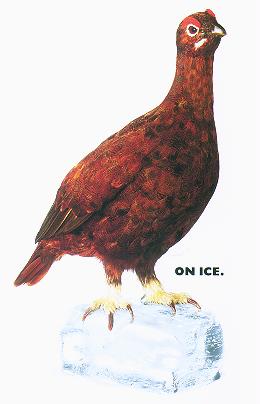
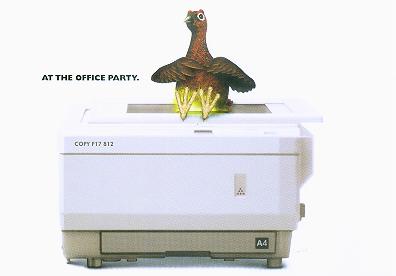
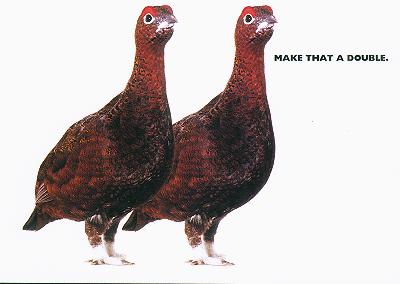
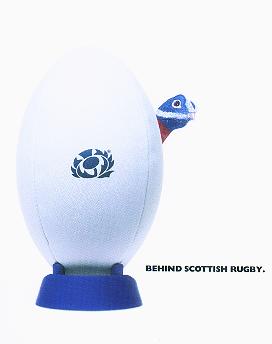
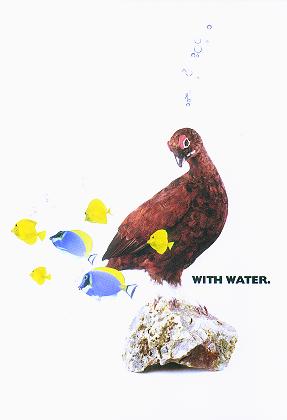

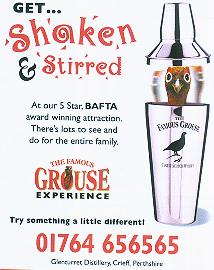
|
